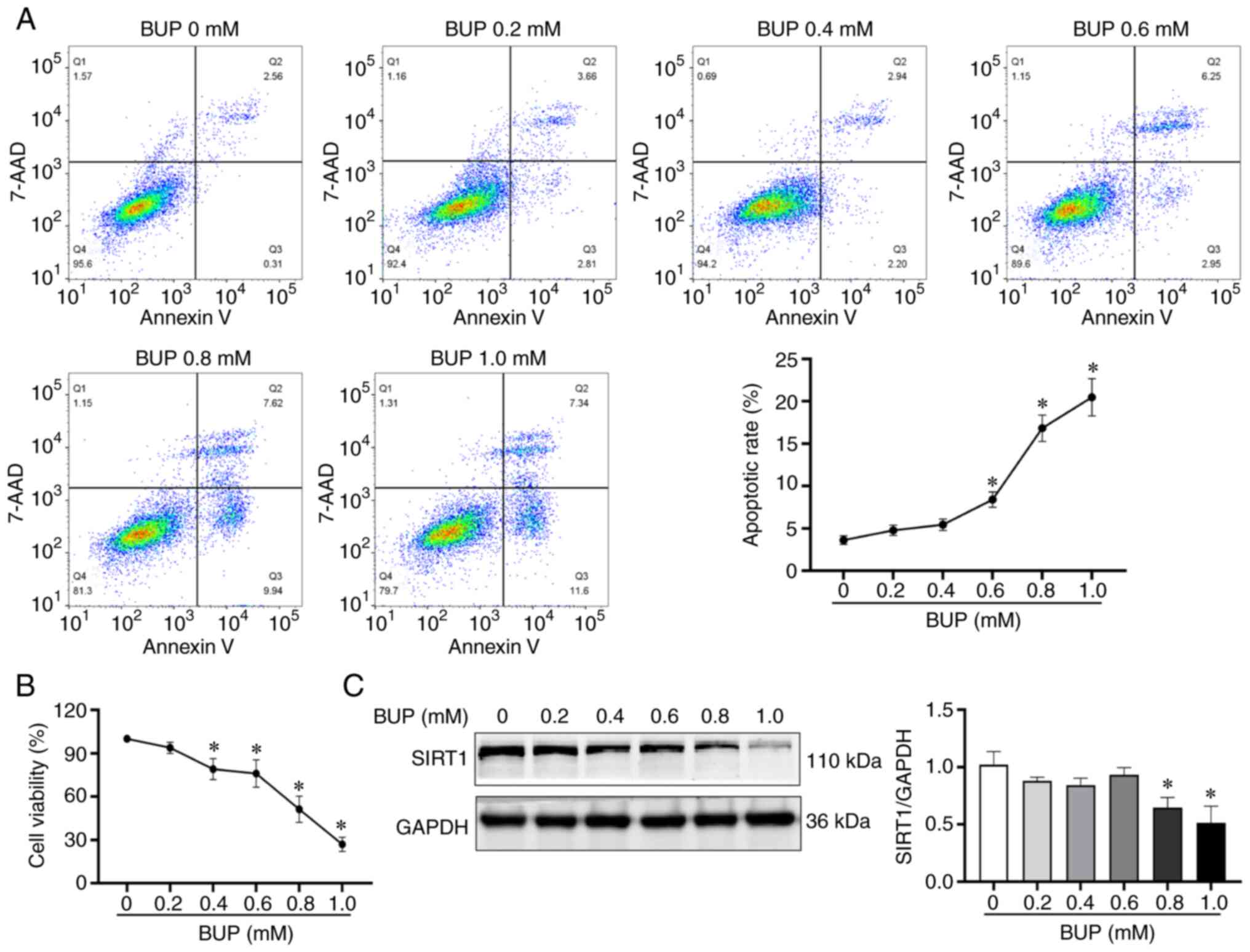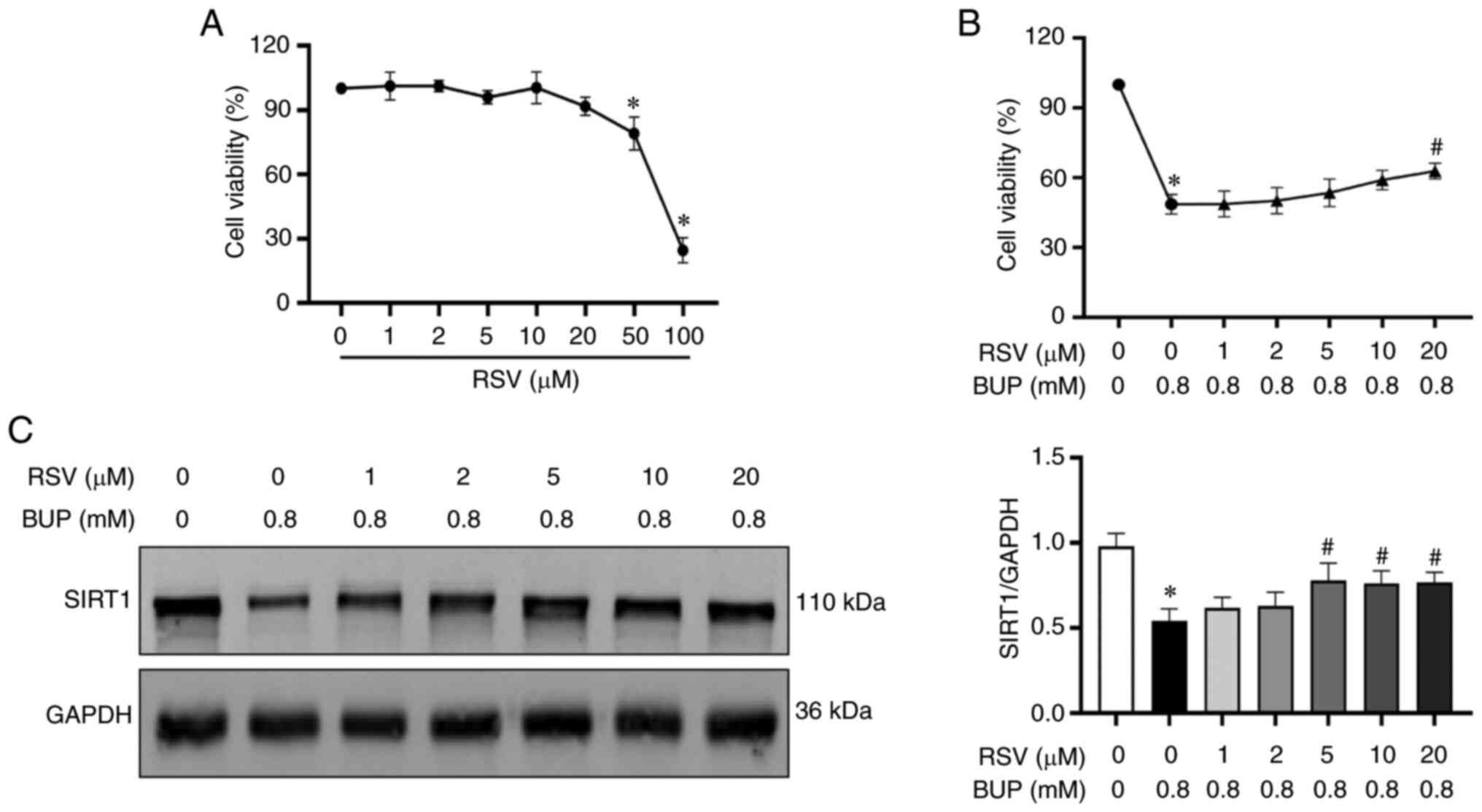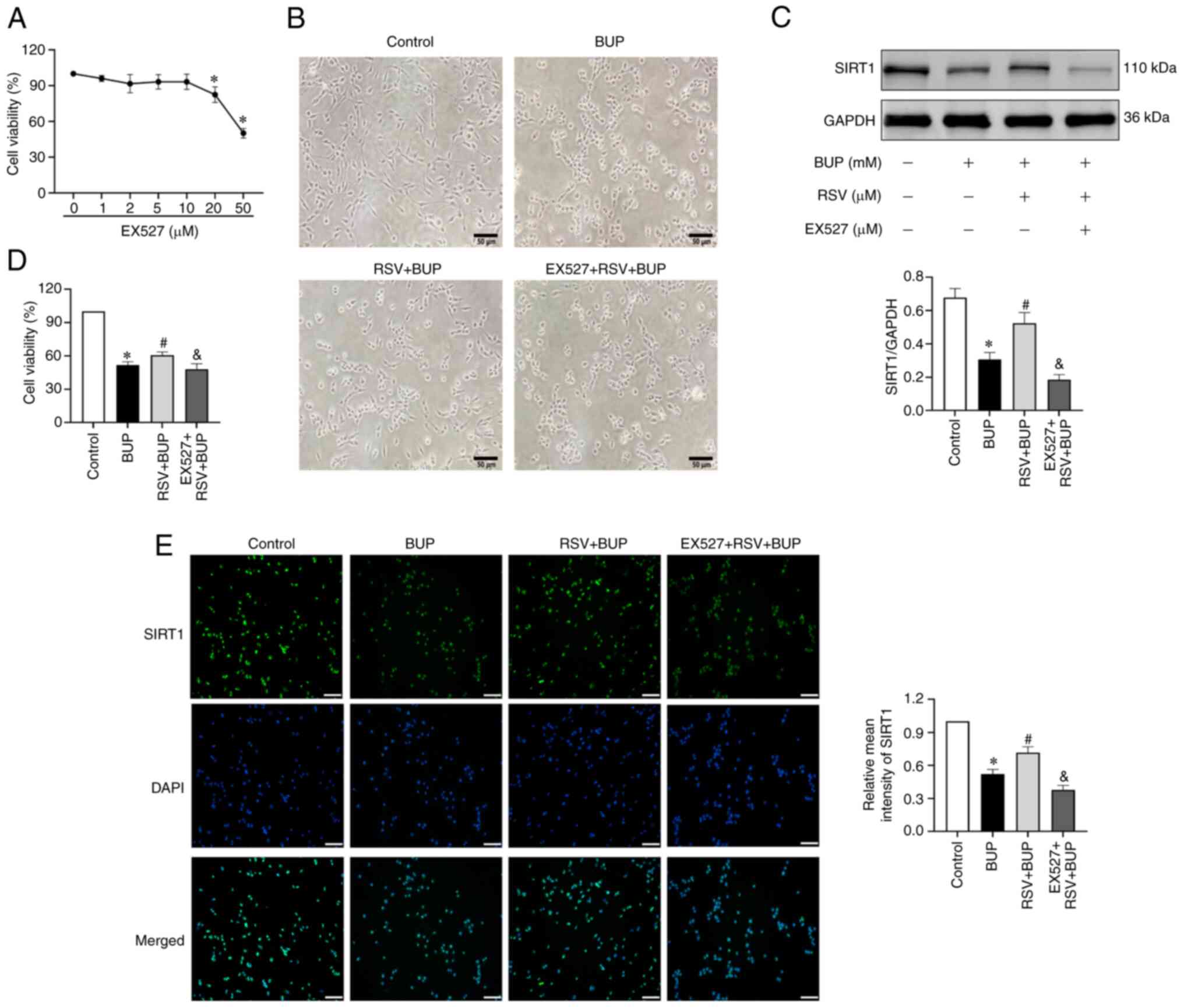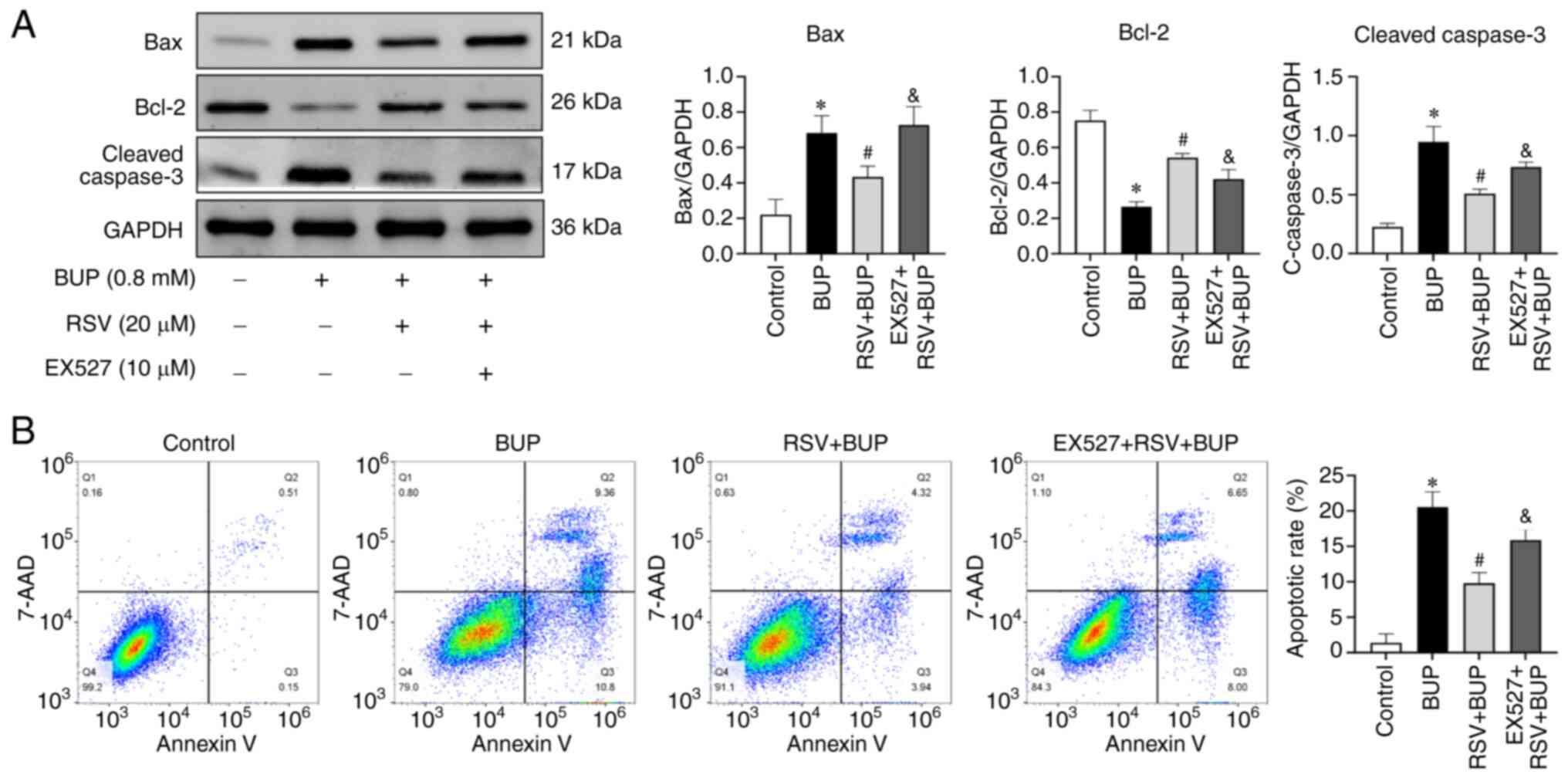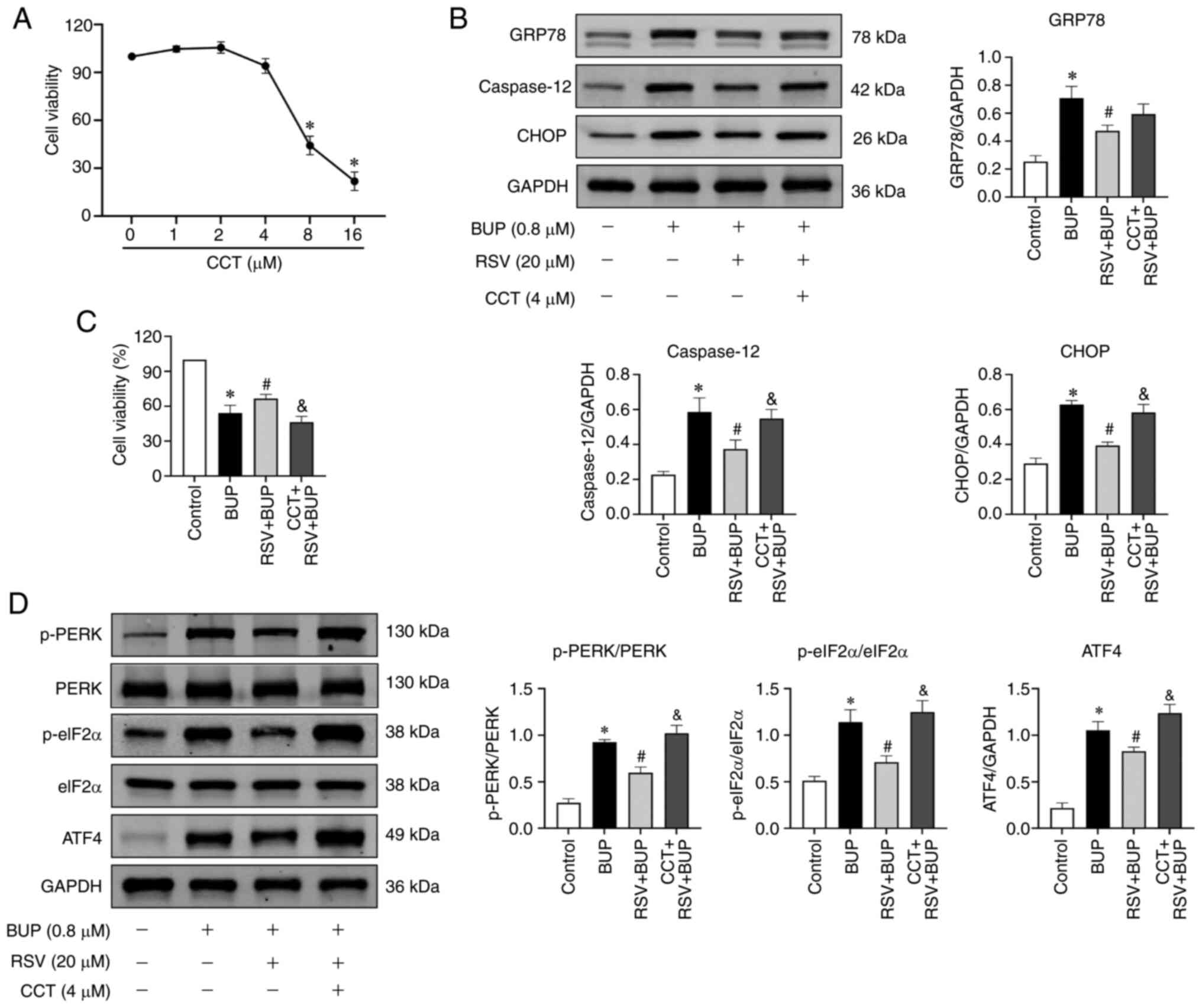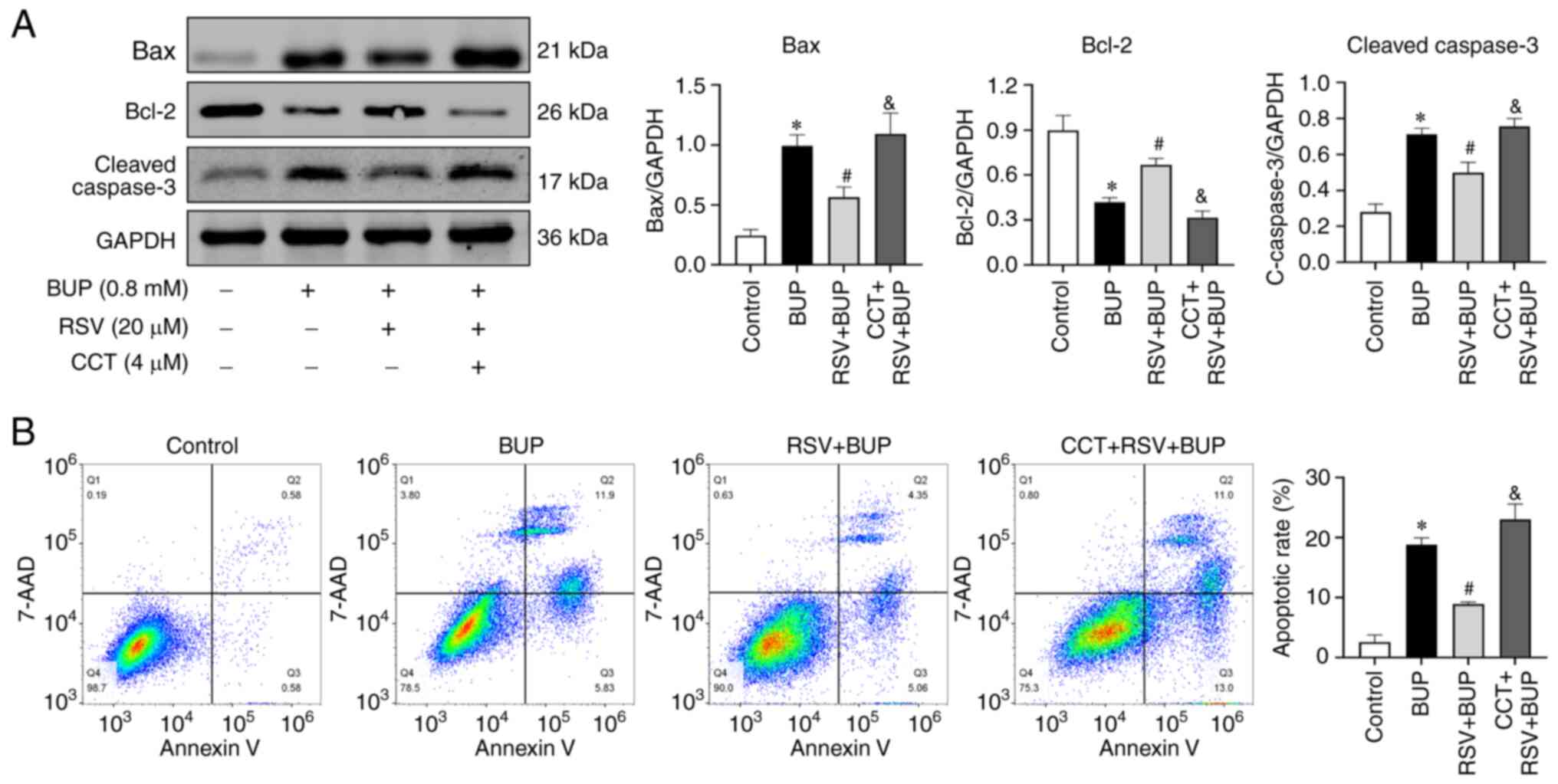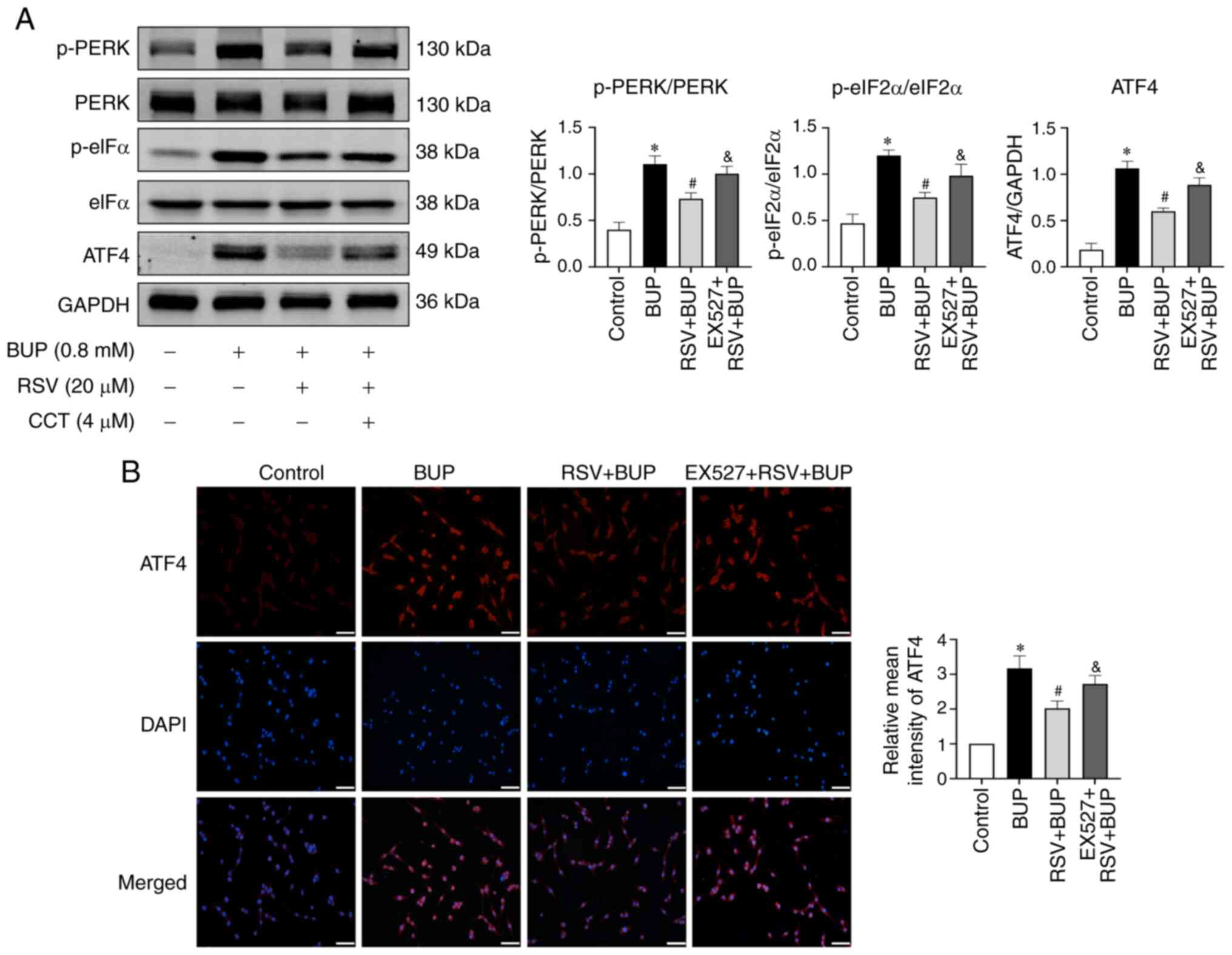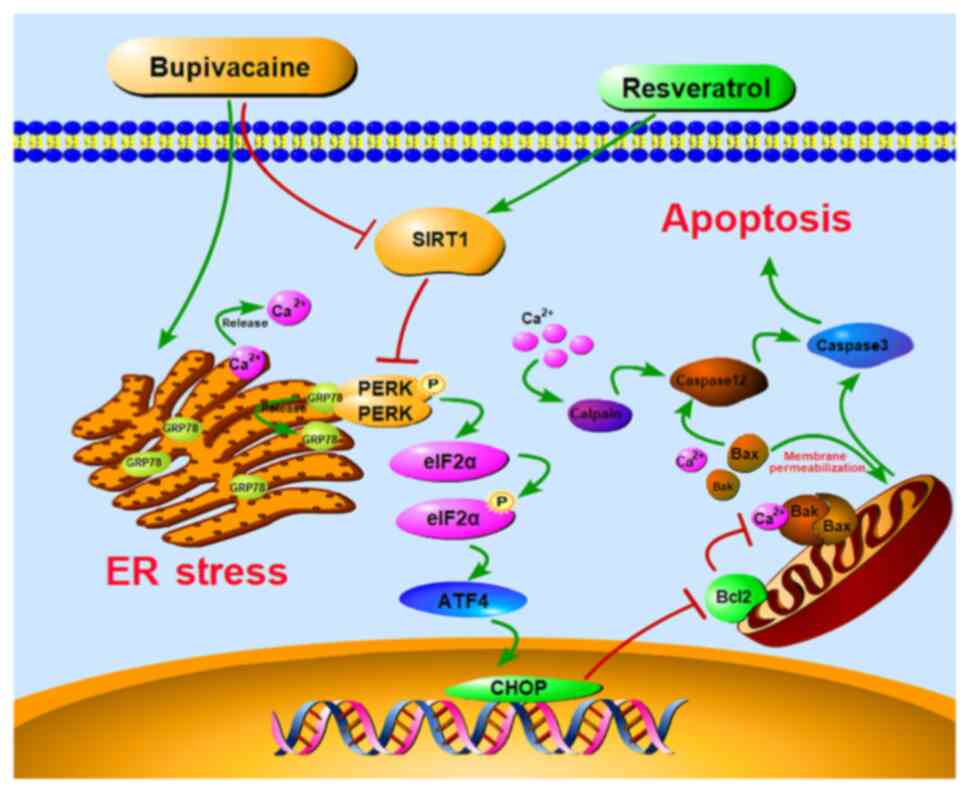Resveratrol‑mediated activation of SIRT1 inhibits the PERK‑eIF2α‑ATF4 pathway and mitigates bupivacaine‑induced neurotoxicity in PC12 cells
- Authors:
- Published online on: July 24, 2023 https://doi.org/10.3892/etm.2023.12132
- Article Number: 433
-
Copyright: © Luo et al. This is an open access article distributed under the terms of Creative Commons Attribution License.
Abstract
Introduction
Bupivacaine (BUP) is a widely used local anesthetic for regional anesthesia and pain management. However, it is associated with potential neurotoxic effects, which may lead to neurological complications in intraspinal anesthesia and systemic toxicity when used as a local anesthetic, even when administered within the clinically approved dose range (1). Our previous studies have shown that BUP-induced neurotoxicity is associated with apoptosis, activation of the nucleotide-binding oligomerization domain-like receptor family pyrin domain-containing 3 (NLRP3) inflammasome and ferroptosis (2-4). Nevertheless, the molecular mechanism underlying BUP-induced neurotoxicity remains incompletely understood due to its complexity.
The endoplasmic reticulum (ER) is an essential cellular organelle that plays a crucial role in protein synthesis, which is essential for normal cellular functions and cell survival (5). However, ER stress can arise when an overload of calcium ions or the accumulation of unfolded proteins occurs, which activates the unfolded protein response (UPR) to restore protein homeostasis. The UPR pathway involves the signaling of three types of transmembrane proteins on the ER, namely inositol-requiring enzyme 1 (IRE1), protein kinase RNA-like ER kinase (PERK) and activating transcription factor 6(6). Specifically, the PERK signaling pathway can inhibit new protein synthesis, which may promote cell survival or death; notably, when ER stress is prolonged, the PERK signaling pathway may ultimately result in apoptosis (7). A previous study demonstrated that ER stress is a critical contributor to BUP-induced neurotoxicity (8). In our previous in vivo study, the results indicated that BUP induces neurotoxic effects by activating apoptosis via the mitochondrial pathway (9). In our subsequent in vitro study, it was found that activation of the PERK-eukaryotic translation initiation factor 2 α (eIF2α)-activating transcription factor 4 (ATF4) pathway leads to apoptosis and contributes to BUP-induced spinal neurotoxicity in rats (10). However, the precise molecular mechanism by which BUP induces activation of the PERK-eIF2α-ATF4 signaling pathway is currently not fully understood and requires further investigation.
Sirtuin 1 (SIRT1) is a nicotinamide adenine dinucleotide-dependent enzyme that belongs to the class III histone deacetylase family. SIRT1 exerts protective effects against cellular damage via the deacetylation of downstream substrates and modulation of biological processes such as metabolism regulation, DNA damage repair, cell cycle control, stress response and apoptosis (11). Previous studies have suggested that the downregulation of SIRT1 is a major contributor to the pathogenesis of neurological disorders such as Parkinson's disease, Alzheimer's disease, spinal cord injury and cerebral ischemia-reperfusion injury (12-14). A recent study elucidated the involvement of SIRT1 in the neurotoxicity caused by local anesthesia (15). Furthermore, the inhibition of ER stress has been established as an important mechanism via which SIRT1 exerts protective effects in various diseases, such as myocardial ischemia reperfusion injury, hepatic steatosis, chronic obstructive pulmonary disease and inflammatory bowel diseases (16-20). Also, a study demonstrated that SIRT1 stimulates growth-plate chondrogenesis by attenuating the PERK-eIF2α-CHOP pathway (21). However, the potential association between SIRT1 and the PERK-eIF2α-ATF4 pathway in BUP-induced neurotoxicity has not yet been investigated.
Resveratrol (RSV) is a natural polyphenol present in various plant sources, including grapes, nuts, wine and berries, which has been shown to yield neuroprotective effects through the activation of SIRT1(22). In our previous study, compelling evidence was provided that RSV inhibits ER stress, reduces neuronal apoptosis and alleviates BUP-induced spinal neurotoxicity in rats via the upregulation of SIRT1 expression and suppression of PERK-eIF2α-ATF4 pathway activation (23). The aim of the present study was to determine the association between SIRT1 and PERK signaling pathways in the context of the RSV-mediated attenuation of BUP-induced cytotoxicity in PC12 cells. The findings of this study may provide a new perspective on the potential of RSV as a targeted therapeutic approach for the treatment of BUP-induced neurotoxicity.
Materials and methods
Materials
PC12 rat adrenal pheochromocytoma cells were obtained from Icell Bioscience Inc., Shanghai. BUP hydrochloride and RSV were purchased from Sigma-Aldrich (Merck KGaA), while CCT020312 and EX527 were obtained from MedChemExpress. High-glucose Dulbecco's modified Eagle's medium (DMEM) and fetal bovine serum (FBS) were purchased from Gibco (Thermo Fisher Scientific, Inc.). The Cell Counting Kit-8 (CCK-8) was supplied by Biosharp Life Sciences, and the Annexin V/7-aminoactinomycin D (7-AAD) apoptosis detection kit was provided by BD Biosciences. Antibodies against SIRT1 (cat. no. ab110304) and caspase-12 (cat. no. ab62484) were purchased from Abcam; antibodies against PERK (cat. no. 3192S), phosphorylated (p)-eIF2α (cat. no. 3398T), eIF2α (cat. no. 5324T), CHOP (cat. no. 5554T) and ATF4 (cat. no. 11815) were supplied by Cell Signaling Technology, Inc.; antibodies against Bax (cat. no. 60267-1-Ig), Bcl-2 (cat. no. 26593-1-AP), glucose-regulated protein 78 (GRP78; cat. no. 11587-1-AP) and GAPDH (cat. no 10494-1-AP) were provided by Proteintech Group, Inc.; and antibodies against cleaved caspase-3 (cat. no. WL02117) and p-PERK (cat. no. WL05295) were obtained from Wanleibio Co., Ltd.
Cell culture and treatment
PC12 cells were cultured in high-glucose DMEM supplemented with 10% FBS and 1% penicillin-streptomycin at 37˚C in a 5% CO2 incubator. The culture medium was refreshed every day. To establish the BUP-induced cytotoxicity model, PC12 cells were incubated with 0-1.0 mM BUP for 24 h at 37˚C. In the RSV + BUP groups, 0-20 µM RSV was applied to PC12 cells for 2 h at 37˚C, followed by cotreatment 0.8 mM BUP for 24 h at 37˚C. Moreover, in the EX527 + RSV + BUP and CCT + RSV + BUP pretreatment groups, the cells were pretreated with SIRT1 inhibitor EX527 (10 µM) and PERK activator CCT020312 (4 µM) for 30 min at 37˚C, followed by co-treatment with RSV (20 µM) and BUP (0.8 mM) for 24 h at 37˚C. PC12 cells not exposed to any experimental treatments or interventions were regarded as the control group.
Cell viability
The CCK-8 assay was used to determine the viability of PC12 cells following the manufacturer's instructions. Cells were seeded at a density of 3x103 cells per well in 96-well plates and incubated for 24 h. After treatment, cells were incubated with 10% CCK-8 solution for 1 h. An enzyme-linked immunometric meter was used to measure the average optical density at 450 nm.
Light microscopy
PC12 cells were seeded in 24-well plates at a density of 2x104 cells/well and incubated for 24 h. Subsequently, the PC12 cells were subjected to various interventions. An inverted phase-contrast microscope (Leica Microsystems GmbH) was used to examine cell morphology, and images were captured at x200 magnification.
Flow cytometry
To measure the apoptosis rate, flow cytometry was performed with the Annexin V/7-AAD apoptosis detection kit in accordance with the manufacturer's instructions. PC12 cells were seeded in 6-well plates at a density of 2x105 cells per well. After various interventions, the cells were collected and resuspended in 500 µl binding buffer for 5 min. After double staining the cell preparations with Annexin V and 7-AAD for 5 min at room temperature in the dark, cell analysis was performed using a CytoFLEX Flow Cytometer (Beckman Coulter, Inc.). The acquired data were subsequently analyzed using FlowJo software v. 10.8.1 (FlowJo LLC).
Immunofluorescence assay
PC12 cells were first seeded onto 14-mm round coverslips in a 24-well plate. After rinsing with phosphate-buffered saline (PBS), the cells on the coverslips were fixed in 4% paraformaldehyde for 15 min at room temperature. Following permeabilization with 0.5% Triton-X100 for 15 min, the cells were blocked with 10% goat serum (BIOSS) for 40 min at room temperature. The cells were incubated overnight at 4˚C with primary antibodies against SIRT1 (diluted 1:500) and ATF4 (diluted 1:300). After rinsing with PBS, the cells were incubated with secondary antibodies (diluted 1:300) labeled with Alexa Fluor 488 (cat. no. ab150133; Abcam) or Alexa Fluor 594 (cat. no. ab150080; Abcam) for 1 h at room temperature. The cells were then stained with DAPI (diluted 1:1,000) for 30 min at room temperature to stain the nuclei. Finally, images were captured using a fluorescent microscope (BX53; Olympus Corporation) at x200 magnification, and the mean fluorescence intensity was determined using ImageJ software v.1.53 (National Institutes of Health).
Western blot analysis
PC12 cells were lysed with RIPA lysis buffer (Beijing Solarbio Science & Technology Co., Ltd.), and the protein concentration was determined using the BCA method. An equal amount (20 µg) of protein was loaded per lane and subjected to electrophoresis on a 10% SDS-PAGE gel. The separated proteins were then transferred to PVDF membranes. After blocking with 5% skimmed milk for 1 h at room temperature, the cells were incubated overnight at 4˚C with primary antibodies against p-PERK, PERK, ATF4, CHOP, p-eIF2α, eIF2α, caspase-12, Bcl-2, cleaved caspase-3, GRP78, Bax and GAPDH (all diluted 1:1,000). After washing three times with Tris-buffered saline with 0.05% Tween 20, the membranes were incubated with infrared-labeled goat anti-rabbit or goat anti-mouse secondary antibodies (1:10,000; Invitrogen; Thermo Fisher Scientific, Inc.) for 1 h at 4˚C. An LI-COR Odyssey Infrared imaging system (Li-Cor Biosciences) was used to obtain the array image. The protein blot intensities were quantified using ImageJ software v.1.53 (National Institutes of Health) and normalized to the protein levels of the GAPDH loading control.
Statistical analysis
SPSS version 25.0 (IBM Corp.) was used to perform the statistical analyses of the data presented in the study. Three independent experiments were conducted for all assays. Data are presented as the mean ± SEM. Differences among groups were analyzed using one-way ANOVA followed by Tukey's post hoc tests. P<0.05 was considered to indicate a statistically significant difference.
Results
BUP downregulates SIRT1, decreases viability and increases apoptosis in PC12 cells
To investigate the mechanisms underlying the cytotoxicity of BUP on PC12 cells, PC12 cells were exposed to various concentrations of BUP for 24 h. The cell viability, apoptosis rate and SIRT1 protein expression levels of the cells were evaluated using CCK-8, flow cytometry and western blot assays, respectively. As shown in Fig. 1, BUP induced apoptosis, reduced SIRT1 protein levels and decreased cell viability in PC12 cells in a concentration-dependent manner. The cell viability in the 0.2, 0.4, 0.6, 0.8 and 1.0 mM BUP groups was 95.89±3.66, 76.01±2.79, 73.70±5.90, 54.55±4.37 and 28.87±2.63%, respectively, compared with that in the control group. Based on these results, 0.8 mM BUP was selected as the optimal concentration for BUP-induced PC12 cell cytotoxicity induction in subsequent experiments.
RSV treatment alleviates BUP-induced cytotoxicity in PC12 cells
To determine the protective effect of RSV on BUP-induced cytotoxicity, PC12 cells were incubated with various concentrations of RSV for 24 h. Cell viability was then evaluated via the CCK-8 assay. As shown in Fig. 2A, no significant change in cell viability was observed in cells treated with RSV concentrations of 0-20 µM. However, cells treated with 50 or 100 µM RSV exhibited significantly decreased viability compared with untreated cells. Subsequently, cells were treated with different concentrations (0, 1, 2, 5, 10 and 20 µM) of RSV for 2 h, followed by cotreatment with 0.8 mM BUP for 24 h to evaluate the protective effect of RSV against BUP-induced cell injury. As shown in Fig. 2B and C, treatment with 5, 10 and 20 µM RSV upregulated SIRT1 protein expression in PC12 cells compared with that in the cells treated with BUP alone, and treatment with 20 µM RSV restored cell viability. Accordingly, the optimal concentration of RSV was identified to be 20 µM, which was used to investigate the protective effect on BUP-induced cytotoxicity in subsequent experiments.
RSV protects PC12 cells against BUP-induced apoptosis via upregulation of SIRT1 protein expression
To investigate the mechanism underlying the RSV-mediated protection of PC12 cells against BUP-induced cytotoxicity, the role of SIRT1 was evaluated using the SIRT1 inhibitor EX527. First, the optimal concentration of EX527 was determined using a CCK-8 assay. Based on the results shown in Fig. 3A, 10 µM was selected as the optimal treatment concentration. PC12 cells were then treated with BUP alone or in combination with RSV, or pretreated with EX527 followed by RSV and BUP cotreatment. As shown in Fig. 3B-E, morphological analysis revealed that BUP induced cellular shrinkage, membrane blebbing and the retraction of protrusions in PC12 cells, which was accompanied by decreased cell viability and SIRT1 protein levels compared with those in the control group. RSV attenuated the BUP-induced reductions in SIRT1 protein expression and cell viability. It also mitigated the BUP-induced pathological changes. Furthermore, pretreatment with EX527 reversed the RSV-induced change in the expression levels of SIRT1 and abolished the protective effect of RSV against BUP-induced cytotoxicity. These results suggest that the upregulation of SIRT1 mediates the protective effect of RSV against BUP-induced cytotoxicity in PC12 cells.
To further investigate whether SIRT1 is involved in the protective effect of RSV against BUP-induced apoptosis, the expression levels of apoptotic proteins and the apoptosis rates of the PC12 cells were detected by western blotting and flow cytometry, respectively. As shown in Fig. 4, BUP increased pro-apoptotic Bax and cleaved caspase-3 protein expression and decreased anti-apoptotic Bcl-2 protein expression, resulting in an increased apoptosis rate compared with that in the control group. In the RSV + BUP group compared with the BUP group, the Bax and cleaved caspase-3 protein levels and apoptosis rate were decreased, while the expression of Bcl-2 was increased. However, pretreatment with EX527 attenuated the effects of RSV on apoptotic protein expression and increased the apoptosis rate compared with that in the RSV + BUP group. These results suggest that the protective effect of RSV against BUP-induced apoptosis in PC12 cells is mediated by the upregulation of SIRT1.
RSV protects against BUP-induced apoptosis through PERK pathway inhibition
To further elucidate the molecular mechanisms underlying the protective effect of RSV on BUP-induced apoptosis, the expression levels of proteins associated with the PERK signaling pathway and ER stress were analyzed. The role of the PERK signaling pathway was evaluated using the PERK activator CCT020312. First, the optimal concentration of CCT020312 was determined using a CCK-8 assay. Based on the results shown in Fig. 5A, 4 µM was selected as the optimal treatment concentration for subsequent experiments. The western blotting and CCK-8 assay results shown in Fig. 5B-D indicate that BUP induced ER stress and activated the PERK pathway, as evidenced by increased levels of the ER stress marker proteins GRP78, caspase-12 and CHOP, as well as the PERK pathway-associated proteins p-PERK, p-eIF2α and ATF4 in the BUP group compared with the control group. However, compared with those in the BUP group, the levels of GRP78, caspase-12, CHOP, p-PERK, p-eIF2α and ATF4 proteins were decreased in the RSV + BUP group. Pretreatment with 4 µM CCT020312 increased the protein levels of p-PERK, p-eIF2α, ATF4, caspase-12 and CHOP compared with those in the RSV + BUP group. These data indicate that RSV inhibits BUP-induced ER stress and PERK/eIF2α/ATF4 pathway activation.
To further elucidate the role of the PERK-eIF2α-ATF4 pathway in the protective effects of RSV against BUP-induced apoptosis, the expression levels of apoptotic proteins and the rate of apoptosis were assessed in each experimental group using western blotting and flow cytometry, respectively. As shown in Fig. 6, the Bax and cleaved caspase-3 proteins levels were elevated, Bcl-2 protein levels were reduced and the rate of apoptosis was increased in the CCT + RSV + BUP group compared with the RSV + BUP group. These findings suggest that RSV mitigates BUP-induced apoptosis by inhibiting the PERK-eIF2α-ATF4 pathway in PC12 cells.
RSV inhibits the PERK-eIF2α-ATF4 pathway by increasing SIRT1 expression
To investigate the potential role of SIRT1 in the inhibitory effect of RSV on the PERK-eIF2α-ATF4 pathway, the protein levels of p-PERK, p-eIF2α, and ATF4 were detected in the EX527 + RSV + BUP group using western blotting and immunofluorescence assays. As shown in Fig. 7, pretreatment with 10 µM EX527 significantly reversed the inhibitory effect of RSV on p-PERK, p-eIF2α and ATF4 protein levels when compared with the RSV + BUP group. These findings suggest that RSV may inhibit the PERK-eIF2α-ATF4 pathway via the upregulation of SIRT1 expression in BUP-exposed PC12 cells.
Discussion
In the present study, the changes in the viability of PC12 cells treated with BUP were evaluated at a 24-h time point. This time point was selected based on the results of preliminary experiments and consideration of previous studies (24-29). Additional experiments using a SIRT1 inhibitor and PERK pathway agonist were then conducted to evaluate the regulatory relationship between SIRT1 and the PERK pathway in the context of the RSV-mediated attenuation of BUP-induced neurotoxicity. The main findings of the present study are as follows. Firstly, it provides the first evidence of the involvement of SIRT1 in BUP-induced neurotoxicity. By using a SIRT1 inhibitor, EX527, it was confirmed that the neuroprotective effect of RSV against BUP-induced neurotoxicity is achieved through the upregulation of SIRT1 expression. Secondly, it reveals that a PERK pathway agonist can attenuate the ability of RSV to reduce BUP-induced apoptosis in PC12 cells. This finding suggests that the PERK pathway plays a crucial role in mediating the protective effects of RSV against BUP-induced neurotoxicity. Finally, the research findings suggest that RSV blocks the PERK-eIF2α-ATF4 pathway of ER stress by increasing SIRT1 expression in BUP-exposed PC12 cells. These findings contribute to an improved understanding of the molecular mechanisms involved in BUP-induced neurotoxicity and highlight the neuroprotective potential of RSV through its regulatory effect on the SIRT1 and PERK signaling pathways.
SIRT1 is a well-studied member of the sirtuin family that has been shown to be associated with the modulation of various physiological and pathological conditions involving aging, metabolism, oxidative stress, autophagy and inflammation (30-33). As a positive regulator in cellular response, SIRT1 can activate different substrates, including p53, FOXO3 and NF-κB, to alleviate cell damage caused by various factors (34-36). There is an increasing consensus that SIRT1 is a vital player in the protection of cells from apoptosis following injury (14,37,38). RSV is a natural SIRT1 agonist that has shown protective effects against neurotoxicity and neurodegeneration through the activation of SIRT1 (39-42). The present study sought to explore the mechanisms underlying BUP-induced neurotoxicity and the potential protective effects of RSV against the effects of BUP on PC12 cells. The findings demonstrate that BUP significantly reduced cell viability and SIRT1 expression levels in a concentration-dependent manner. Furthermore, RSV treatment inhibited BUP-induced apoptosis via the downregulation of the expression of pro-apoptotic proteins caspase-3 and Bax and upregulation of the expression of Bcl-2. Moreover, to evaluate the involvement of SIRT1 in the protective functions of RSV, EX527, a specific inhibitor of SIRT1 was used in the present study. The results demonstrate that EX527 increased the apoptosis rate and expression levels of caspase-3 and Bax, and decreased the expression of Bcl-2 in the cells cotreated with RSV and BUP, which partially abolished the protective effect of RSV against apoptosis. These data suggest that RSV inhibits BUP-induced apoptosis in PC12 cells via the activation of SIRT1.
ER stress has been linked to the pathogenesis of BUP-induced neurotoxicity in a previous study, in which the inhibition of ER stress was shown to attenuate the apoptosis caused by BUP (43). In the present study, it was discovered that BUP increased the expression of ER stress marker proteins GRP78, caspase-12 and CHOP, while RSV treatment significantly decreased the BUP-induced increases in the expression of these proteins, indicating that RSV suppressed BUP-induced ER stress. Under severe ER stress conditions, PERK dissociates from the molecular chaperone GRP78 and undergoes autophosphorylation through dimerization, leading to the phosphorylation of eIF2α and subsequent upregulation of ATF4 protein expression. It is now understood that CHOP, one of the target genes of ATF4, triggers cell apoptosis by upregulating the expression of the pro-apoptosis protein Bax, while the expression of the anti-apoptosis protein Bcl-2 is downregulated (44). Furthermore, a recent study demonstrated that RSV protects against acrolein-induced ferroptosis and insulin secretion dysfunction via the ER-stress-associated PERK pathway (45). Therefore, the PERK agonist CCT020312 was used in the present study to examine whether the PERK signaling pathway mediates the anti-apoptotic effects of RSV against BUP-induced apoptosis in PC12 cells. The results substantiated that BUP activated the PERK pathway in PC12 cells, as demonstrated by increased levels of p-PERK, p-eIF2α and ATF4, which is consistent with the findings of preliminary experiments in the present study. Treatment with RSV significantly decreased the p-PERK/PERK and p-eIF2α/eIF2α ratios and decreased ATF4 protein expression in BUP-treated PC12 cells. However, pretreatment with CCT020312 increased the p-PERK/PERK and p-eIF2α/eIF2α ratios and the expression levels of ER stress marker proteins caspase-12 and CHOP, indicating that CCT020312 reversed the inhibitory effect of RSV on ER stress. Furthermore, western blotting and flow cytometry were used to quantify the expression of apoptosis-related proteins and the apoptosis rate. The results indicated that CCT020312 partially abolished the protective effect of RSV against BUP-induced apoptosis. Therefore, these results support the hypothesis that the protective effect of RSV against BUP-induced injury in PC12 cells is mediated through the inhibition of the PERK-eIF2α-ATF4 pathway, which thereby exerts an anti-apoptotic effect.
Previous studies have provided evidence to suggest that SIRT1 plays a crucial role in mediating the suppressive effects of RSV on ER stress (46,47). SIRT1 has been shown to block the activation of IRE1 and X-box binding protein 1 (XBP1) through deacetylation under ER stress conditions. For instance, Chou et al (48) reported that RSV or the overexpression of SIRT1 significantly decreased cadmium-induced activation of the IRE-1α/spliced XBP1 pathway and NLRP3 inflammasome, along with pyroptosis. It has been reported that SIRT1 directly interacts with lysine on PERK and eIF2α to regulate PERK activation (49,50). Notably, RSV has been reported to restore cardiac function and reduce cardiomyocyte apoptosis via SIRT1-mediated inhibition of the PERK/eIF2α pathway (50). Therefore, rescue experiments were conducted in the present study to investigate the involvement of SIRT1 in the inhibitory effects of RSV on the PERK signaling pathway. The results showed that EX527 significantly increased the p-PERK/PERK and p-eIF2α/eIF2α ratios and decreased the expression of ATF4 in the cells treated with RSV and BUP, indicating that SIRT1 mediates the suppressive effects of RSV on the PERK-eIF2α-ATF4 pathway. A graphical image depicting the proposed mechanism in which RSV-mediated SIRT1 upregulation protects against BUP-induced neurotoxicity via inhibition of the PERK-eIF2α-ATF4 pathway is shown in Fig. 8.
The present study has three limitations that should be acknowledged. Firstly, the changes in cell viability were only evaluated at a single time point (24 h) after the treatment of PC12 cells with BUP. The effects of BUP, RSV and EX527 on PC12 cell viability were not investigated at different time points. Secondly, GAPDH was used as a loading control to quantify the target bands in the western blot analysis, with the aim of standardizing the quantification. The expression of full-length caspase-3 protein was not analyzed for comparison with cleaved caspase-3, which could have provided a more accurate assessment. Thirdly, the interaction between SIRT1 and the proteins in the PERK signaling pathway was not directly investigated. Further research is necessary to identify the specific proteins within the PERK signaling pathway that are targeted by SIRT1 deacetylation in BUP-induced neurotoxicity.
In summary, the present study reveals that SIRT1 plays a pivotal role in the pathogenesis of BUP-induced neurotoxicity by modulating activation of the PERK-eIF2α-ATF4 signaling pathway. Compelling evidence that RSV protects against BUP-induced PC12 cell apoptosis via the upregulation of SIRT1 expression and subsequent inhibition of the PERK-eIF2α-ATF4 signaling pathway is provided. These findings highlight potential therapeutic targets and strategies for the treatment of BUP-induced neurotoxicity.
Acknowledgements
Not applicable.
Funding
Funding: This research was funded by the Innovation Project of Guangxi Graduate Education (grant no. YCBZ2022091).
Availability of data and materials
The datasets used and/or analyzed during the current study are available from the corresponding author on reasonable request.
Authors' contributions
YL was responsible for data curation, investigation, conceptualization and writing the original draft of the manuscript. NH was responsible for data curation, software and visualization. YZ was responsible for investigation, data curation and validation. JLa was responsible for investigation, data curation and validation. XL was responsible for data curation, validation, software and investigation. JLi was responsible for project administration, conceptualization, writing, reviewing and editing the manuscript, visualization and validation. YL and JLi confirm the authenticity of all the raw data. All authors read and approved the final version of the manuscript.
Ethics approval and consent to participate
Not applicable.
Patient consent for publication
Not applicable.
Competing interests
The authors declare that they have no competing interests.
References
|
Chen X, Xu Z, Lin R and Liu Z: Persistent cauda equina syndrome after cesarean section under combined spinal-epidural anesthesia: A case report. J Clin Anesth. 27:520–523. 2015.PubMed/NCBI View Article : Google Scholar | |
|
Ji J, Yan X, Li Z, Lai Z and Liu J: Therapeutic effects of intrathecal versus intravenous monosialoganglioside against bupivacaine-induced spinal neurotoxicity in rats. Biomed Pharmacother. 69:311–316. 2015.PubMed/NCBI View Article : Google Scholar | |
|
Lai J, Ji JM, Chen MY, Luo YP, Yu Y, Zhou G, Wei LL, Huang LS and Liu JC: Melatonin ameliorates bupivacaine-induced spinal neurotoxicity in rats by suppressing neuronal NLRP3 inflammasome activation. Neurosci Lett. 772(136472)2022.PubMed/NCBI View Article : Google Scholar | |
|
Zhao Y, Luo Y, Liu Z, Chen Y, Wei L, Luo X, Zhou G, Lai J, Ji J, Lin Y and Liu J: Ferrostatin-1 ameliorates bupivacaine-induced spinal neurotoxicity in rats by inhibiting ferroptosis. Neurosci Lett. 809(137308)2023.PubMed/NCBI View Article : Google Scholar | |
|
Marciniak SJ, Chambers JE and Ron D: Pharmacological targeting of endoplasmic reticulum stress in disease. Nat Rev Drug Discov. 21:115–140. 2022.PubMed/NCBI View Article : Google Scholar | |
|
Ghemrawi R and Khair M: Endoplasmic reticulum stress and unfolded protein response in neurodegenerative diseases. Int J Mol Sci. 21(6127)2020.PubMed/NCBI View Article : Google Scholar | |
|
Hetz C, Zhang K and Kaufman RJ: Mechanisms, regulation and functions of the unfolded protein response. Nat Rev Mol Cell Biol. 21:421–438. 2020.PubMed/NCBI View Article : Google Scholar | |
|
Li L, Zhang QG, Lai LY, Wen XJ, Zheng T, Cheung CW, Zhou SQ and Xu SY: Neuroprotective effect of ginkgolide B on bupivacaine-induced apoptosis in SH-SY5Y cells. Oxid Med Cell Longev. 2013(159864)2013.PubMed/NCBI View Article : Google Scholar | |
|
Liang Y, Ji J, Lin Y, He Y and Liu J: The Ganglioside GM-1 inhibits bupivacaine-induced neurotoxicity in mouse neuroblastoma Neuro2a cells. Cell Biochem Funct. 34:455–462. 2016.PubMed/NCBI View Article : Google Scholar | |
|
Liu B, Ji J, Feng Q, Luo X, Yan X, Ni Y, He Y, Mao Z and Liu J: Monosialoganglioside protects against bupivacaine-induced neurotoxicity caused by endoplasmic reticulum stress in rats. Drug Des Devel Ther. 13:707–718. 2019.PubMed/NCBI View Article : Google Scholar | |
|
Liu H, Xu S, Wang C, Deng Y, Xu B, Yang T, Sun J and Liu W: The beneficial role of sirtuin 1 in preventive or therapeutic options of neurodegenerative diseases. Neuroscience. 504:79–92. 2022.PubMed/NCBI View Article : Google Scholar | |
|
Tang BL and Chua CE: SIRT1 and neuronal diseases. Mol Aspects Med. 29:187–200. 2008.PubMed/NCBI View Article : Google Scholar | |
|
Fangma Y, Wan H, Shao C, Jin L and He Y: Research progress on the role of sirtuin 1 in cerebral ischemia. Cell Mol Neurobiol. 43:1769–1783. 2023.PubMed/NCBI View Article : Google Scholar | |
|
Yu X, Zhang S, Zhao D, Zhang X, Xia C, Wang T, Zhang M, Liu T, Huang W and Wu B: SIRT1 inhibits apoptosis in in vivo and in vitro models of spinal cord injury via microRNA-494. Int J Mol Med. 43:1758–1768. 2019.PubMed/NCBI View Article : Google Scholar | |
|
Zheng LN, Guo FQ, Li ZS, Wang Z, Ma JH, Wang T, Wei JF and Zhang WW: Dexmedetomidine protects against lidocaine-induced neurotoxicity through SIRT1 downregulation-mediated activation of FOXO3a. Hum Exp Toxicol. 39:1213–1223. 2020.PubMed/NCBI View Article : Google Scholar | |
|
Wang X, Yuan B, Cheng B, Liu Y, Zhang B, Wang X, Lin X, Yang B and Gong G: Crocin alleviates myocardial ischemia/reperfusion-induced endoplasmic reticulum stress via regulation of miR-34a/Sirt1/Nrf2 pathway. Shock. 51:123–130. 2019.PubMed/NCBI View Article : Google Scholar | |
|
Li YP, Wang SL, Liu B, Tang L, Kuang RR, Wang XB, Zhao C, Song XD, Cao XM, Wu X, et al: Sulforaphane prevents rat cardiomyocytes from hypoxia/reoxygenation injury in vitro via activating SIRT1 and subsequently inhibiting ER stress. Acta Pharmacol Sin. 37:344–353. 2016.PubMed/NCBI View Article : Google Scholar | |
|
Zheng X, Xu F, Liang H, Cao H, Cai M, Xu W and Weng J: SIRT1/HSF1/HSP pathway is essential for exenatide-alleviated, lipid-induced hepatic endoplasmic reticulum stress. Hepatology. 66:809–824. 2017.PubMed/NCBI View Article : Google Scholar | |
|
He B, Zhang W, Qiao J, Peng Z and Chai X: Melatonin protects against COPD by attenuating apoptosis and endoplasmic reticulum stress via upregulating SIRT1 expression in rats. Can J Physiol Pharmacol. 97:386–391. 2019.PubMed/NCBI View Article : Google Scholar | |
|
Melhem H, Hansmannel F, Bressenot A, Battaglia-Hsu SF, Billioud V, Alberto JM, Gueant JL and Peyrin-Biroulet L: Methyl-deficient diet promotes colitis and SIRT1-mediated endoplasmic reticulum stress. Gut. 65:595–606. 2016.PubMed/NCBI View Article : Google Scholar | |
|
Kang X, Yang W, Wang R, Xie T, Li H, Feng D, Jin X, Sun H and Wu S: Sirtuin-1 (SIRT1) stimulates growth-plate chondrogenesis by attenuating the PERK-eIF-2α-CHOP pathway in the unfolded protein response. J Biol Chem. 293:8614–8625. 2018.PubMed/NCBI View Article : Google Scholar | |
|
Shaito A, Posadino AM, Younes N, Hasan H, Halabi S, Alhababi D, Al-Mohannadi A, Abdel-Rahman WM, Eid AH, Nasrallah GK and Pintus G: Potential adverse effects of resveratrol: A literature review. Int J Mol Sci. 21(2084)2020.PubMed/NCBI View Article : Google Scholar | |
|
Luo Y, Zhao Y, Lai J, Wei L, Zhou G, Yu Y and Liu J: Resveratrol suppresses bupivacaine-induced spinal neurotoxicity in rats by inhibiting endoplasmic reticulum stress via SIRT1 modulation. Biomed Res Int. 2023(1176232)2023.PubMed/NCBI View Article : Google Scholar | |
|
Fan X, Bian W, Liu M, Li J and Wang Y: MiRNA-429 alleviates ketamine-induced neurotoxicity through targeting BAG5. Environ Toxicol. 36:620–627. 2021.PubMed/NCBI View Article : Google Scholar | |
|
Hao R, Ge J, Song X, Li F, Sun-Waterhouse D and Li D: Cadmium induces ferroptosis and apoptosis by modulating miR-34a-5p/Sirt1axis in PC12 cells. Environ Toxicol. 37:41–51. 2022.PubMed/NCBI View Article : Google Scholar | |
|
Shayan M, Mehri S, Razavi BM and Hosseinzadeh H: Minocycline protects PC12 cells against cadmium-induced neurotoxicity by modulating apoptosis. Biol Trace Elem Res. 201:1946–1954. 2023.PubMed/NCBI View Article : Google Scholar | |
|
Tang XP, Guo XH, Geng D and Weng LJ: d-Limonene protects PC12 cells against corticosterone-induced neurotoxicity by activating the AMPK pathway. Environ Toxicol Pharmacol. 70(103192)2019.PubMed/NCBI View Article : Google Scholar | |
|
Zhang Y, He Y, Deng N, Chen Y, Huang J and Xie W: Protective effect of resveratrol against corticosterone-induced neurotoxicity in PC12 cells. Transl Neurosci. 10:235–240. 2019.PubMed/NCBI View Article : Google Scholar | |
|
Yang Z, Hu S, He Y and Ji L: LINC00665 rescues bupivacaine induced neurotoxicity in human neural cell of SH-SY5Y through has-miR-34a-5p. Brain Res Bull. 177:210–216. 2021.PubMed/NCBI View Article : Google Scholar | |
|
Jęśko H, Wencel P, Strosznajder RP and Strosznajder JB: Sirtuins and their roles in brain aging and neurodegenerative disorders. Neurochem Res. 42:876–890. 2017.PubMed/NCBI View Article : Google Scholar | |
|
Zhang Y, Li T, Pan M, Wang W, Huang W, Yuan Y, Xie Z, Chen Y, Peng J, Li X and Meng Y: SIRT1 prevents cigarette smoking-induced lung fibroblasts activation by regulating mitochondrial oxidative stress and lipid metabolism. J Transl Med. 20(222)2022.PubMed/NCBI View Article : Google Scholar | |
|
Ren Q, Hu Z, Jiang Y, Tan X, Botchway BOA, Amin N, Lin G, Geng Y and Fang M: SIRT1 protects against apoptosis by promoting autophagy in the oxygen glucose deprivation/reperfusion-induced injury. Front Neurol. 10(1289)2019.PubMed/NCBI View Article : Google Scholar | |
|
Jiao F and Gong Z: The beneficial roles of SIRT1 in neuroinflammation-related diseases. Oxid Med Cell Longev. 2020(6782872)2020.PubMed/NCBI View Article : Google Scholar | |
|
Chen H, Lin X, Yi X, Liu X, Yu R, Fan W, Ling Y, Liu Y and Xie W: SIRT1-mediated p53 deacetylation inhibits ferroptosis and alleviates heat stress-induced lung epithelial cells injury. Int J Hyperthermia. 39:977–986. 2022.PubMed/NCBI View Article : Google Scholar | |
|
Chen L, Li S, Zhu J, You A, Huang X, Yi X and Xue M: Mangiferin prevents myocardial infarction-induced apoptosis and heart failure in mice by activating the Sirt1/FoxO3a pathway. J Cell Mol Med. 25:2944–2955. 2021.PubMed/NCBI View Article : Google Scholar | |
|
Kaewmool C, Kongtawelert P, Phitak T, Pothacharoen P and Udomruk S: Protocatechuic acid inhibits inflammatory responses in LPS-activated BV2 microglia via regulating SIRT1/NF-κB pathway contributed to the suppression of microglial activation-induced PC12 cell apoptosis. J Neuroimmunol. 341(577164)2020.PubMed/NCBI View Article : Google Scholar | |
|
Mao H, Wang L, Xiong Y, Jiang G and Liu X: Fucoxanthin attenuates oxidative damage by activating the Sirt1/Nrf2/HO-1 signaling pathway to protect the kidney from ischemia-reperfusion injury. Oxid Med Cell Longev. 2022(7444430)2022.PubMed/NCBI View Article : Google Scholar | |
|
Wang F, Ma J, Wang J, Chen M, Xia H, Yao S and Zhang D: SIRT1 ameliorated septic associated-lung injury and macrophages apoptosis via inhibiting endoplasmic reticulum stress. Cell Signal. 97(110398)2022.PubMed/NCBI View Article : Google Scholar | |
|
Wang H, Dong X, Liu Z, Zhu S, Liu H, Fan W, Hu Y, Hu T, Yu Y, Li Y, et al: Resveratrol suppresses rotenone-induced neurotoxicity through activation of SIRT1/Akt1 signaling pathway. Anat Rec (Hoboken). 301:1115–1125. 2018.PubMed/NCBI View Article : Google Scholar | |
|
Tang X, Zhao Y, Zhou Z, Yan J, Zhou B, Chi X, Luo A and Li S: Resveratrol mitigates sevoflurane-induced neurotoxicity by the SIRT1-dependent regulation of BDNF expression in developing mice. Oxid Med Cell Longev. 2020(9018624)2020.PubMed/NCBI View Article : Google Scholar | |
|
Bai L, Liu R, Wang R, Xin Y, Wu Z, Ba Y, Zhang H, Cheng X, Zhou G and Huang H: Attenuation of Pb-induced Aβ generation and autophagic dysfunction via activation of SIRT1: Neuroprotective properties of resveratrol. Ecotoxicol Environ Saf. 222(112511)2021.PubMed/NCBI View Article : Google Scholar | |
|
Gomes BAQ, Silva JPB, Romeiro CFR, Dos Santos SM, Rodrigues CA, Gonçalves PR, Sakai JT, Mendes PFS, Varela ELP and Monteiro MC: Neuroprotective mechanisms of resveratrol in Alzheimer's disease: Role of SIRT1. Oxid Med Cell Longev. 2018(8152373)2018.PubMed/NCBI View Article : Google Scholar | |
|
Li L, Ye XP, Lu AZ, Zhou SQ, Liu H, Liu ZJ, Jiang S and Xu SY: Hyperglycemia magnifies bupivacaine-induced cell apoptosis triggered by mitochondria dysfunction and endoplasmic reticulum stress. J Neurosci Res. 91:786–798. 2013.PubMed/NCBI View Article : Google Scholar | |
|
Iurlaro R and Muñoz-Pinedo C: Cell death induced by endoplasmic reticulum stress. FEBS J. 283:2640–2652. 2016.PubMed/NCBI View Article : Google Scholar | |
|
Zhang X, Jiang L, Chen H, Wei S, Yao K, Sun X, Yang G, Jiang L, Zhang C, Wang N, et al: Resveratrol protected acrolein-induced ferroptosis and insulin secretion dysfunction via ER-stress-related PERK pathway in MIN6 cells. Toxicology. 465(153048)2022.PubMed/NCBI View Article : Google Scholar | |
|
Shati AA: Resveratrol protects against cadmium chloride-induced hippocampal neurotoxicity by inhibiting ER stress and GAAD 153 and activating sirtuin 1/AMPK/Akt. Environ Toxicol. 34:1340–1353. 2019.PubMed/NCBI View Article : Google Scholar | |
|
Zhu H, Li X, Qiao M, Sun X and Li G: Resveratrol alleviates inflammation and ER stress through SIRT1/NRF2 to delay ovarian aging in a short-lived fish. J Gerontol A Biol Sci Med Sci. 78:596–602. 2023.PubMed/NCBI View Article : Google Scholar | |
|
Chou X, Ding F, Zhang X, Ding X, Gao H and Wu Q: Sirtuin-1 ameliorates cadmium-induced endoplasmic reticulum stress and pyroptosis through XBP-1s deacetylation in human renal tubular epithelial cells. Arch Toxicol. 93:965–986. 2019.PubMed/NCBI View Article : Google Scholar | |
|
Zhang Y, He L, Tu M, Huang M, Chen Y, Pan D, Peng J and Shen X: The ameliorative effect of terpinen-4-ol on ER stress-induced vascular calcification depends on SIRT1-mediated regulation of PERK acetylation. Pharmacol Res. 170(105629)2021.PubMed/NCBI View Article : Google Scholar | |
|
Prola A, Pires Da Silva J, Guilbert A, Lecru L, Piquereau J, Ribeiro M, Mateo P, Gressette M, Fortin D, Boursier C, et al: SIRT1 protects the heart from ER stress-induced cell death through eIF2α deacetylation. Cell Death Differ. 24:343–356. 2017.PubMed/NCBI View Article : Google Scholar |



